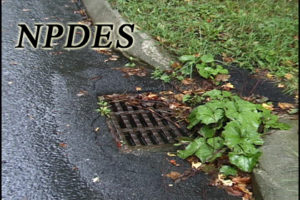
National Pollution Discharge Elimination System (NPDES)
EPA’s program for regulating the discharge of pollutants into our waters.
Disclaimer: We are not legal experts. We have learned what we know about environmental regulations by working with the public and with local, state, and federal regulators. BEAT suggests that you consult the actual texts of the laws and regulations or the local, state, and federal agencies responsible for administering and enforcing these laws and regulations if you have legal questions.
From the website of the US Environmental Protection Agency:
“The NPDES permit program addresses water pollution by regulating point sources that discharge pollutants to waters of the United States. … Created in 1972 by the Clean Water Act, the NPDES permit program is authorized to state governments by EPA to perform many permitting, administrative, and enforcement aspects of the program.”
BEAT’s NOTE: Massachusetts is one of the states not authorized by EPA to administer the NPDES program. In Massachusetts, this program is administered directly by EPA.
There are 12 program areas in NPDES. They are:
| 1. Animal Feeding Operations (AFOs) | 7. National Pretreatment Program |
| 2. Aquaculture | 8. Pesticide Applications |
| 3. Biosolids | 9. Stormwater |
| 4. Forest Roads | 10. Vessels Incidental Discharge Permitting |
| 5. Industrial Wastewater | 11. Water Quality Trading |
| 6. Municipal Wastewater | 12. Whole Effluent Toxicity (WET) |
9. STORMWATER
The Stormwater program area has eight categories:
| 1. Stormwater Discharges from Construction Activities | 5. Oil and Gas Stormwater Permitting |
| 2. Stormwater Discharges from Industrial Activities | 6. EPA's Residual Designation Authority |
| 3. Stormwater Discharges from Municipal Sources | 7. Stormwater Rules and Notices |
| 4. Stormwater Discharges from Transportation Sources | 8. Stormwater Maintenance |
1. Stormwater Discharges From Construction Activities
Any construction site one acre or larger must obtain authorization to discharge stormwater by obtaining a NPDES construction stormwater permit. The one-acre limit may not be circumvented by dividing a one-acre or larger construction site into a number of smaller sites. The purpose of the program is to minimize harm to the environment from runoff from construction sites.
The operator must submit a Notice of Intent (NOI), develop a Stormwater Pollution Prevention Plan (SWPPP), implement the SWPPP’s Best Management Practices (BMPs), and complete an endangered species determination for the project site.
There is a 7-day waiting period after the filing of the NOI during which time the NOI is reviewed by EPA, U.S. Fish and Wildlife Service, and National Marine Fisheries Service.
EPA’s website has more specific information on NPDES Stormwater permits for Construction Activities.
You can search on EPA’s website to see stormwater NOIs filed for projects in your town.
2. Stormwater Discharge From Industrial Activities
In order to minimize the impact of stormwater discharges from industrial sites, any industrial site that falls within one of 10 categories defined by the Environmental Protection Agency and that discharges or has the potential to discharge stormwater into a municipal stormwater system or directly into a body of water must obtain a NPDES industrial stormwater permit. This permit is also called a Multi-Sector General Permit for Industrial Activities (MSGP).
The MSGP provides facility-specific requirements for many types of industrial facilities within one overall permit. The permit outlines steps that facility operators must take prior to being eligible for permit coverage, including development and implementation of a stormwater pollution prevention plan (SWPPP).
EPA’s website has more specific information on NPDES Stormwater permits for Industrial Activities and guidance on SWPPPs.
3. Stormwater Discharges From Municipal Sources
NPDES stormwater permits for municipal separate storm sewer systems (MS4) cover municipal stormwater systems and some non-municipal stormwater systems as well. Stormwater systems must be designed to prevent harmful pollutants from being washed by stormwater runoff into the stormwater system or into local waterbodies. The MS4 permitting process is relatively new and is being phased in over time. In Berkshire County only Pittsfield is required to have an MS4 permit, and it is covered under a small MS4 permit.
There are three categories of permitting based on the size of the municipality covered by the system.
A small MS4 covers systems serving a population of up to 100,000.
A medium MS4 covers systems serving a population of 100,000 to 249,999.
A large MS4 covers systems serving a population of 250,000 or more.
The EPA website has further information on small MS4 permits and requirements.
